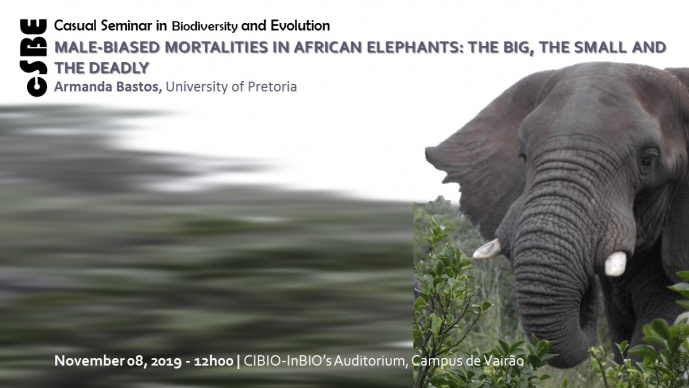MALE-BIASED MORTALITIES IN AFRICAN ELEPHANTS: THE BIG, THE SMALL AND THE DEADLY

CASUAL SEMINAR IN BIODIVERSITY AND EVOLUTION

Extreme gender-biased mortalities are rarely observed in free-living wildlife. However, from 1993-94, male-biased mortalities were recorded in African elephants (Loxodonta africana) from the Kruger National Park, and in 2007, a mass die-off of sub-Antarctic fur seals (Arctocephalus tropicalis) occurred on sub-Antarctic Marion Island. In both cases, there was an extreme gender bias in mortalities, with 83% and 100% of the individuals that succumbed over an 11 and 1-month period, respectively, being adult males. Whereas encephalomyocarditis (EMC) virus was confirmed to be the causative agent of the African elephant mortalities, the cause of the mass fur-seal die-off seals could not be determined due to the inability to secure appropriate samples. Subsequent screening of invasive house mice on Marion Island, the only rodent species on the island, for EMC virus presence was also unsuccessful, due most likely to the 6-month interval between the seal die-off and apparently very low levels of inter-epidemic EMC virus circulation in rodent reservoir hosts. The latter has been suggested following extensive sampling and testing of Mastomys reservoir host species in the Kruger National Park. Molecular characterisation of viruses isolated from elephant heart tissue indicates that the outbreak strains are distinct from global EMC viruses and most closely related to the original Mengo virus strain. Although the vaccine strain used in the aftermath of the elephant mortalities has recently been shown to differ from the outbreak strain, this vaccine was protective when trialled in African elephants. Efforts to develop a vaccine that matches strains specific to Africa are underway to ensure that effective counter-measures to EMC outbreaks in elephants are in place.
Armanda Bastos research focuses on the epidemiology of infectious diseases of wildlife and incorporates molecular approaches to determine origin, persistence and spread of diseases of animal and public health concern. Integral to many projects is the custom development of molecular methods that address the high levels of host and pathogen diversity in sub-Saharan Africa and the generation of baseline data that facilitate formulation of regionally-relevant, conservation-cognisant disease control policies. Current research focusses on (i) the ecology and diversity of a broad range of viral and bacterial, vector-borne and zoonotic diseases, and (ii) on the molecular taxonomy and population genetics of diverse African fauna.
[Host: Fernando Tavares, Microbial Diversity and Evolution]
Image credits: Armanda Bastos